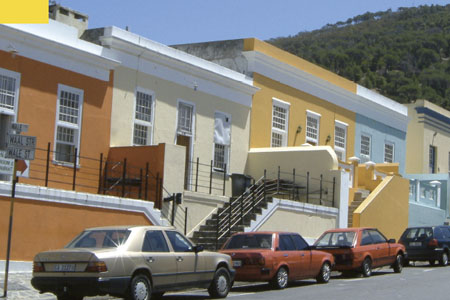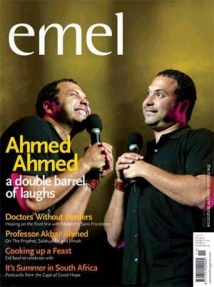
The Cape
Issue 8 Nov / Dec 2004
Almost 300 years before Nelson Mandela was imprisoned on Robben Island, a far less famous but equally heroic figure was destined to share a similar fate - Sayed Abdurrahman Motura. First Published on November/December 2004
To access the issue page, click here
Today's Muslim visitor will find that Cape Town is like a city adorned with precious jewels from its rich and vibrant Islamic history."
Almost 300 years before Nelson Mandela was imprisoned upon Robben Island, a far less famous but equally heroic figure was destined to share a similar fate upon that small plot of land. This earlier, less familiar political exile was in fact a 17th Century Indonesian Muslim. His name was Sayed Abdurrahman Motura, or ‘Tuan Matarah’, as he came to be known. Similar to Mr Mandela, Tuan Matarah’s ‘crime’ was simply his resistance to the oppressive regime of his time. His grave still stands upon Robben Island where he died. South African Muslims consider his shrine a symbol of the triumph of truth over falsehood and liberation over oppression. It is also a reminder of the sacrifice our ancestors made so that we could be free, and we could be Muslim.
The future of the Indonesian Muslims who landed in South Africa during the 17th Century was bleak. The penalty they paid for having resisted Dutch colonisation of Indonesia was exile to Cape Town, where they were either forced into slavery, or incarcerated. In an endeavour to extinguish Islam in South Africa, public practising of the religion was forbidden – the Dutch authorities even ordered the Christianisation of all slaves in the Cape at the time. But although the Dutch had succeeded in physically imprisoning these ‘rebellious’ Indonesians, their attempts to cage the minds, hearts and souls of the Muslims was a failure. Unbeknown to the Dutch authorities, the Muslim exiles would pass on the sacred knowledge in the dead of night, teaching and making dhikr at secret meetings in the mountain caves and slave cabins. For many of the Indonesian political exiles were deeply spiritual, well educated people of noble birth. Amongst this group were those such as Shaykh Yusuf of Makasar – a Sufi saint and prince of Java who is considered by many as one of the founders of Islam in South Africa. His tomb stands at Faure, outside Cape Town in an area that has become known as ‘Makasar’, due to the legacy left by the Indonesians who founded the first South African Muslim community there.
After decades of concealing their religion, public recognition of Islam was eventually granted to the Muslims 150 years after the arrival of the first Indonesians in Cape Town. In 1806 at Battle of Blaaubergstrand, an English commander named Admiral Sir Home Riggs Popham was surprised to observe the Muslims fighting so bravely amongst the Dutch troops. Upon hearing that the Dutch had promised the Muslims freedom of religion and a mosque in return for fightingin their ranks, he was so moved by the courage of the Indonesians that despite the Cape colony passing from Dutch to English hands, he honoured the promise of the Dutch. And so the first mosque, the ‘Masjid Awwal’ was built in Cape Town.
Today’s Muslim visitor will find that Cape Town is like a city adorned with precious jewels from its rich and vibrant Islamic history. Traces of the Muslim heritage are scattered all over. The first sound of the day is a reminder of the potent Muslim presence in the city as the adhan echoes from the natural acoustics provided by Table Mountain. The graves or ‘kramats’ of the early Muslim Saints still exist, forming a ring around the Cape. The most popular of these are the tombs of Shaykh Yusuf at Faure and Tuan Matarah on Robben Island. Bo-Kaap (meaning ‘Upper-Cape’ in Afrikaans) is the name of the picturesque, predominantly Muslim ‘Malay quarter’ of Cape Town. Its distinctive houses, painted in lemon sherbet, raspberry ripple and pistachio colours are nestled in Signal Hill, at the foot of Table Mountain. Several Muslim Saints are buried in and around the Bo-Kaap/ Signal Hill area.
The famous prison on Robben Island is a must-see destination. Nelson Mandela stated that the endurance of the first Muslim prisoners upon Robben Island gave him strength and hope during his period of incarceration. Visitors are greeted by a plaque engraved with the inspirational words of Ahmed Kathrada, one of Mandela’s closest companions: “While we will not forget the brutality of apartheid, we will not want Robben Island to be a monument of our hardship and suffering... We would want it to be a triumph of the human spirit against the forces of evil, a triumph of wisdom and largeness of spirit against small minds and pettiness, a triumph of courage and determination over human frailty and weakness.” (Ahmed Kathrada, 1993). This sentiment was certainly expressed by my tour guide – an ex-political prisoner who gave a fascinating first-hand account of his sentence and experiences during apartheid. In addition to the prison and kramat of Tuang Matarah, Robben Island boasts a magnificent view of Table Mountain and the Cape Town waterfront.
Tourists can pick up souvenirs and indulge in retail therapy at the many Cape Town shopping centres – the most popular being the ‘Victoria and Alfred Waterfront’. In addition to the shopping centre, the Waterfront complex also houses the ‘Two Oceans Aquarium’, the ‘Red Shed’ craft market and the Scratch Patch’ – where visitors can admire and purchase semi-precious gemstones. However, for great bargains on everything from leather and jewellery to traditional arts and crafts, head to the flea markets for a more authentic experience. Green Market Square has become world famous – apparently, Kate Moss shops there! Cape Town has been blessed with tremendous natural beauty and the adventurous visitor will enjoy a trek up Table Mountain.
Believe me, the breath-taking view from the top is worth all that hard work! But for the less active tourist, a cable car service runs regularly up and down the mountain. Those with an interest in horticulture will enjoy walks amongst the flora and fauna at Kirstenbosch Gardens. Safari tours in Port Elizabeth, Kruger National Park and Kwazulu- Natal can be booked from Cape Town. The city is also famous for its crystal clear waters and long expanses of white sandy beaches. Take a drive along the peninsular for striking sea views, and stop off at one of the many beaches, such as Clifton Bay to enjoy the sand and sea. The peninsular drive to Chapman’s Peak lookout point is stunning. Furthermore, the city’s prime location on the coast ensures that the seafood is second to none. The Muslim traveller to Cape Town will be pleased to know that most public restaurants order their meat from halal suppliers, so eating out does not necessarily mean opting for vegetarian cuisine – however, do double check before consuming. The restaurants and cafes in and around Signal Hill and Bo-Kaap offer traditional South African Islamic cooking, which is an exotic mixture of Indonesian, Indian and Dutch. The koeksisters (spicy doughnuts dipped in syrup and topped with coconut) come highly recommended!
For accommodation, Muslim travellers can enjoy the warm and welcoming Signal Hill Lodge (www. signalhilllodge.com), which has hosted the nasheed group ‘Raihaan’ and numerous Muslim dignitaries from all over the world. It is a halal bed and breakfast, and alcohol is strictly forbidden on the premises. Furthermore, the lodge donates all of its profits to educational causes amongst all communities (Muslim and non-Muslim) of South Africa.
South African seasons are the direct opposite to English ones. The best times to visit South Africa are therefore in March/April (South African Autumn) and September/October (South African Spring). Some find the Summer heat unbearable and Winter can be very cold in South African houses that have primarily been built for warm weather. The famous wintry wind called the ‘Cape Doctor’ is said to blow away the illness of the people – hence the very appropriate name for this beautiful and vibrant city – the ‘Cape of Good Hope’.
Bookmark this |
|
Add to DIGG |
|
Add to del.icio.us |
|
Stumble this |
|
Share on Facebook |
|
Share this |
|
Send to a Friend |
|
Link to this |
|
Printer Friendly |
|
Print in plain text |
|


Comments
0 Comments